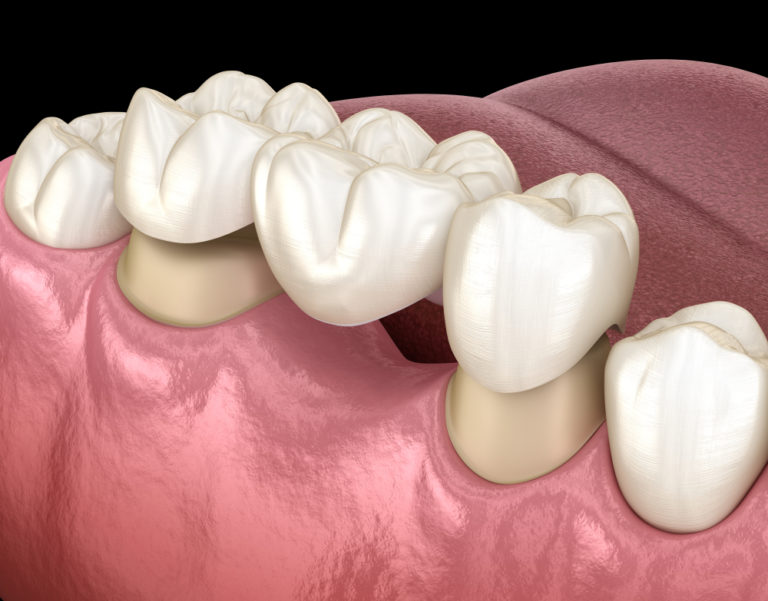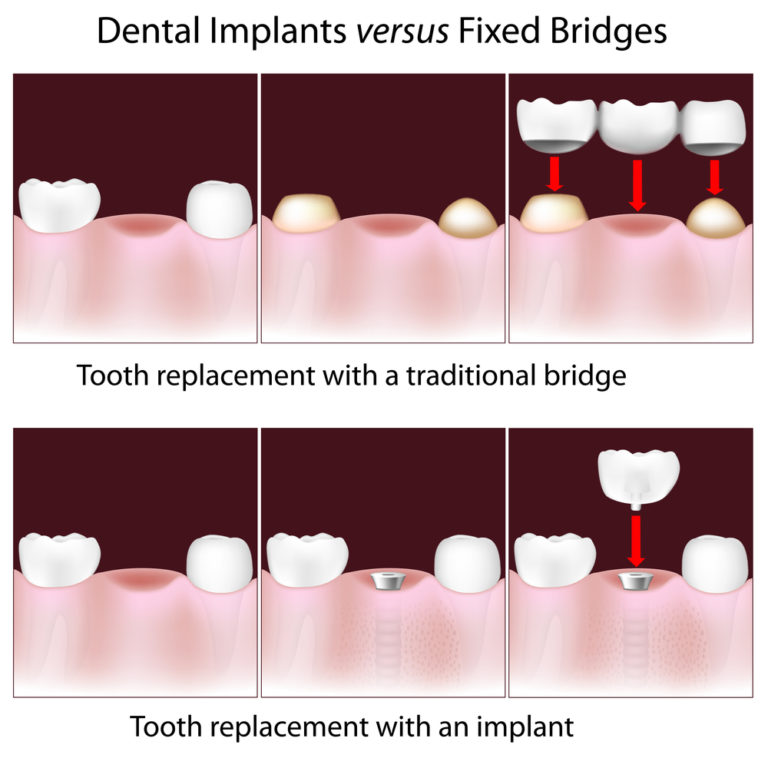Are you missing a tooth? If you want to replace it, one of the treatment options you will be given is a dental bridge. Bridges are an alternative to dental implants for replacing missing teeth.
The technical name of a bridge is a Fixed Partial Denture, or FPD. The term “fixed” means it is not removable. You cannot take it out. “Partial” refers to the fact that it replaces some missing teeth, but not all of them. And a “denture” is a term describing prosthetic teeth.
How Bridges Work
A bridge replaces a missing tooth by connecting a fake tooth, called a pontic, to the neighboring teeth. The neighboring teeth that hold and support the bridge are called abutments. A bridge requires supporting teeth on both sides of the fake tooth, so the minimum length a bridge can span is three teeth.
A bridge is capable of replacing multiple teeth in a row, but the longer it gets, the lower its success rate. Bridges work best when replacing only one back tooth or two front teeth.
Advantages of Bridges over other Tooth Replacement Options
If you are missing a single tooth, you have the option to replace it with a bridge, a dental implant, or a removable partial denture (RPD).
Removable Partial Denture
Both bridges and dental implants are not removable. Both provide a “glued-in” option for tooth replacement. A removable partial denture, also called simply a partial, uses either metal or plastic to clasp around multiple teeth and can replace multiple missing teeth. It must be taken out and cleaned every night. A partial is the least expensive way to replace missing teeth.
Dental Bridge vs. Implant
As far as cost goes, a dental bridge and a dental implant replacing a single missing tooth are relatively close to the same investment. The biggest difference is the time each treatment takes. You can replace a single missing tooth with a bridge in about 2-3 weeks. You only have to wait the time it takes for the lab to make the bridge.
A dental implant can take anywhere from three to six months to heal into the jawbone. Then, we create the crown to attach to the implant. However, if you qualify and there are no complications, we can place the dental implant and the permanent crown in a single visit. We refer to this process as same-day dental crowns.
One advantage of dental bridges is that sometimes we can incorporate any needed treatment on the neighboring teeth into the bridge. For instance, if the tooth next to a missing space is in trouble and needs a crown, the dental bridge would both replace the missing tooth and cover the neighboring tooth. So a separate crown is no longer necessary.
Conversely, a dental implant has the advantage of keeping the neighboring teeth as they are. If they are healthy, then a dental implant would be the better option. Finally, the dental implant has the advantage of being secured directly to your jaw bone, preventing bone loss and making maintenance easier.
The Dental Bridge Process
Replacing a missing tooth or teeth with a bridge requires two appointments.
First Visit: Preparation
At your first visit, the dentist prepares the neighboring teeth to hold the bridge. The preparation for a bridge is the same as the tooth preparation for a dental crown. To create room for the material covering the tooth, the outer layer of enamel is removed. After the dentist prepares the teeth on both sides of the missing space, we take a mold or digital scan of the teeth. This provides an exact replica of the shape, size and position of the teeth that are ready for a bridge. We cover the prepared teeth with a temporary bridge to keep them safe and healthy while the bridge is made.
Second Visit: Placement
When the new bridge is ready, you will return for your second visit, which includes removal of the temporary bridge, cleanup of the teeth and surrounding tissues, and fitting of the permanent bridge. Your dentist will ensure the proper fit of the bridge by taking an x-ray. This confirms that the bridge will completely seal and protect the supporting teeth.
The dentist also ensures that the bridge provides the right contours and bite forces. Once we confirm a perfect fit, it is permanently attached to the teeth with dental cement.
Bridge Maintenance
There are a few specific maintenance requirements for a dental bridge that are different from a single crown or a dental implant. Because a bridge uses a connection between two teeth to replace a missing one, you cannot floss it normally. Your dentist or dental hygienist will give you the new tools and techniques you need to keep your bridge clean.
Another important aspect of bridge maintenance is consistent dental visits with evaluations, x-rays, and professional teeth cleanings. Because all of the teeth of a dental bridge connect to each other as a single unit, a problem on one tooth affects them all. Staying on top of any red flags or risk factors is absolutely essential to keeping a dental bridge healthy. When we see you on a regular basis, we can help you maintain your bridge for as long as possible!
Frequently Asked Questions
Who is a good candidate for a bridge?
There are several factors that make a dental bridge the best choice for someone’s missing tooth replacement.
- The need to replace a missing tooth relatively quickly
- Teeth adjacent to the missing space that also need major dental work
- A lack of bone in the site of the missing tooth that makes a dental implant impossible
- Someone with health problems that make dental implants a poor treatment choice
Will my dental insurance cover a bridge?
Typically, yes! If you have dental insurance with “major” coverage, it will provide benefits for your bridge. Most plans pay 50% of the bridge costs up to your plan’s maximum amount. Ask our front office insurance experts for the details on your specific insurance plan.
Are bridges expensive?
The cost of a dental bridge varies based on how many teeth it involves. In general, you can take the cost of a dental crown and multiply it by the number of teeth in the bridge to get an estimate of the cost. Usually, the cost of a dental bridge is close to the cost of a dental implant. Once your dentist evaluates the teeth and makes a treatment plan, we will give you the exact cost of your bridge. We do offer several payment options to make your dental bridge affordable!
Are bridges painful?
Each person will have a different answer to this question. Most teeth with dental work experience post-operative sensitivity for the first week or two. In normal, healthy teeth, this sensitivity or tenderness will go away on its own. Most people experience mild to moderate sensitivity to cold liquids and some tenderness on chewing. We recommend a soft diet for the first 3-4 days after a dental bridge procedure.
What our patients say
Or call


